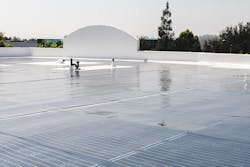Solar cells using established modules outside of traditional setups are offering small airports an opportunity to take advantage of the environmental and economic benefits of solar energy.
The Sunflare LiteMount 60 uses Copper Indium Gallium Diselenide solar cells (CIGS). CIGS is more durable than silicon modules and it can be sputtered onto a stainless steel back sheet. This means solar panels can be mounted on hangar roofs and facilities at smaller airports where traditional solar can’t be placed.
“Each solar module is made up of a bunch of these CIGS stainless steel cells, which gives it a lot of structure and durability,” said Josh Held, vice president of product integration for Sunflare. “Now we don’t need glass to cover it up, we don’t need a big, thick frame to give it structural support to protect that glass.
The Sunflare LiteMount 60 is flexible and is less than 2 mm thick. A lightweight frame can protect the cells and be placed in areas silicon cells can’t be due to weight issues. The LiteMount 60 weigh less than 1lb per square foot, compared to 5lbs. per square foot for a silicon solar panel.
CIGS has been on the market for a long time but Held said it hasn’t been widely adopted because it’s a different manufacturing process than silicon. It’s a similar concept to CIGS, but with a different conductor.
“Airports have a lot of lightweight metal topped buildings, such as hangars or storage facilities,” Held said. “This product works really well for that because lightweight metal top buildings can’t handle the weight of traditional solar panels.”
“A building that can’t handle traditional solar now has the option of putting a solar module on top of it and using that real estate to now have a viable way to go solar,” Held said.
Solar power harvesting can have a significant impact on airports, Held said. Modern panels are very efficient and can offset of utility-based power in a big way.
“Airports have a lot of area where to put the solar modules and make an impact by using their real estate as power generators,” Held said. “With solar, they can have a very significant impact on offsetting their needs they’re currently getting with their utility.”
Solar installations require very little training in terms of upkeep and usage, Held said. Once it’s installed by a qualified integrator, little maintenance is needed. Staff might be trained on software to watch the production of power to see the output the airport is getting. Solar components often have warranties spanning 20 years, so Held said there’s little need for airport staff maintenance.
Ask integrators the pros and cons of the product and do the research with the manufacturers in a solar installation the modules and invertors converting DC to AC power. Held also recommended finding integrators with an existing relationship with the cell providers.
“All solar is an economic evaluation at this point,” he said. “Gather qualified proposals from qualified integrators who understand the economic benefit of solar and knows how to install a system properly.”
About the Author
Joe Petrie
Editor & Chief
Joe Petrie is the Editorial Director for the Endeavor Aviation Group.
Joe has spent the past 20 years writing about the most cutting-edge topics related to transportation and policy in a variety of sectors with an emphasis on transportation issues for the past 15 years.
Contact: Joe Petrie
Editor & Chief | Airport Business
+1-920-568-8399
>> To download the AviationPros media kits, visit: Marketing Resource Center
>>Check out our aviation magazines: Ground Support Worldwide | Airport Business | Aircraft Maintenance Technology

